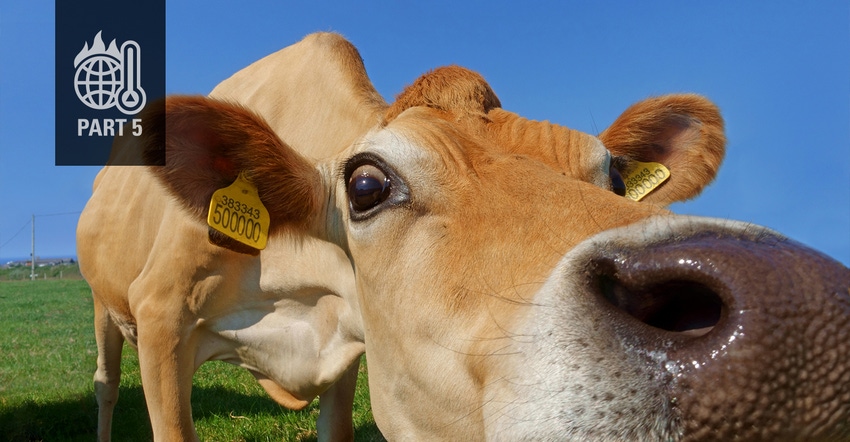
We’ve touched on ways to reduce greenhouse gas (GHG) from crop production, namely through new technologies, adopting climate-smart practices, and carbon trading schemes.
But if there’s one way to get an eco-activist riled up, it’s livestock.
These critics find it easy to lump all greenhouse gas emissions together, including those coming from ruminants. But they are not all the same.
We’re going to get a little sciency here, so bear with me.
CO2 and Nitrous oxide (N2O) are considered ‘long-lived climate pollutants’ while methane from cattle is a ‘short-lived’ pollutant. Methane’s half-life is just 10 years, so it degrades in the atmosphere relatively quickly. CO2’s half-life? 1,000 years! Because it lives for so long it accumulates, and that buildup of warming continues to grow as long as we’re emitting CO2. Nitrous oxide’s half-life is 110 years.
“The methane that our cows and other livestock put out today will be gone after 10 years,” says University of California-Davis professor and air quality specialist Frank Mitloehner. “Methane is not only produced, but methane is also destroyed, and that’s a very important piece most often not considered.”
It certainly wasn’t considered by Burger King, a company that used livestock emissions as a punchline in its condescending ‘cow menu’ commercials; unfortunately for the company, they back fired and enraged both scientists and farmers alike. But make no mistake: fast food chains that sell beef are under pressure to make climate-friendly changes in their supply chains. And, it is important that methane emissions do not increase, as that would add significant warming.
But unlike industry, transportation and energy, the ag sector can create cooling.
“While the world is always thinking of how much greenhouse gas is emitted by different sources, they often don’t think about how certain sectors, such as forestry and agriculture, also serve as a sink for greenhouse gases,” says Mitloehner, who has a PhD. from Texas Tech and is a world expert on livestock air emissions.
How it works
Plants need carbon and water. Carbon as CO2 in the atmosphere is taken in by plants; that carbon is made into carbohydrates such as cellulose starch, or components in feed, and ingested by a cow which then goes into the ruminant’s stomach where some is converted into methane. So the carbon from methane originates in the atmosphere, goes through plants, then into animals, is then emitted, and becomes atmospheric CO2.
This is a biogenic cycle. It’s an important distinction.
“If you have constant or decreasing herd numbers, you’re not adding additional carbon to the atmosphere,” explains Mitloehner. “This is recycled carbon.”

Methane still matters. While it is in the atmosphere it is heat trapping. But the question is, do our livestock herds add additional methane leading to additional warming?
The answer is no -- as long as we have constant or decreasing herds.
A change in the narrative
That is an abrupt change in the livestock narrative -- and should be ag’s theme going forward.
Oxford University research makes it clear that biogenic methane is not the same as fossil-fuel derived methane. It is the same chemically, but the origin and fate are drastically different.
Fossil-fuel based carbon originates from oil, coal and gas, ancient forests and animals that dieda million years ago and got stored in the ground. We extract it and burn it in factories, cars, planes, ships - and by doing so, put it in the atmosphere.
Instead of a cycle, this is a one-way street. The amount of CO2 we put in the atmosphere by far overpowers the potential sinks that take up CO2, like oceans and plants.
“This is the main culprit of greenhouse gases in our atmosphere,” notes Mitloehner. “I have yet to see a climate scientist say it’s the cows who are the primary culprit.”
The new climate heroes
In fact, cows could actually become climate heroes.
“If we reduce methane we could induce global cooling and I think our livestock sector has the potential to do it,” Mitloehner says.
One example for the world lies in California. A few years back, the California legislature wrote a law in which it mandated a 40% reduction in methane to be achieved by the year 2030. Today California's farms and ranches have reduced methane production by 2.2 million metric tons. That amounts to a staggering 25% cut in GHG.
Shunning business-killing regulations, the state instead set up incentives for farmers and ranchers who want to participate. The state helps finance the investment of, let's say, an anaerobic digester or alternative manure management practices.
“The farming community jumped on that and built a lot of facilities to reduce methane,” says Mitloehner. “We are now at 25% of the 40% total reduction.
“To me that's very encouraging. If we can do it here, it can be done in other parts of the country and in other parts of the world.”
If countries want accurate and realistic greenhouse gas reduction goals, they should separate biogenic methane emissions from others, as New Zealand has. The country has a new policy for carbon dioxide and nitrous oxide -- the long-lived climate pollutants -- and different goals and policies around biogenic methane.
The United States should follow New Zealand’s path. Otherwise, “we assign an incorrect blame to livestock, and we get rid of part of it or we regulate them out of business,” says Mitloehner. “Then the only thing that will happen is that they will go someplace else.”
Coming in part six: Farmers, tell your story
Missed some content in this series?
Part one: Will farmers get paid to save the planet?
Part two: What’s at stake in the debate over climate change
Part three: Synthetic fertilizer is a modern miracle but it’s wrecking the atmosphere. Can we do better?
Part four: Is carbon trading an answer?
Part five: Are burping cows really a threat to humanity?
Part six: Farmers, tell your story
Read more about:
ClimateAbout the Author(s)
You May Also Like






